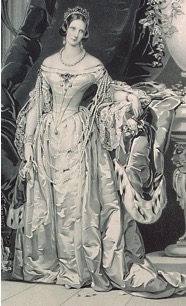Victorian fashion is a fascinating study of the various styles and trends that evolved in British society during the Victorian era, approximately from the 1830s to the 1890s. This period was marked by significant changes in fashion, influenced not only by technological advancements but also by shifts in gender roles, social structures, and artistic movements.
Under the reign of Queen Victoria, England experienced a remarkable period of growth and industrialization, which significantly influenced its fashion landscape. The introduction of the sewing machine in the 1850s and synthetic dyes resulted in quicker and more cost-effective clothing production. This not only transformed the fashion industry but also made high fashion accessible to the burgeoning middle class, fostering a culture of consumerism.

Image: Source Wikipedia
During this era, women’s roles began to shift towards domesticity, with fashion reflecting their private, sedentary lives. The construction of women’s clothing became increasingly elaborate, using multiple layers and stiff corsetry to accentuate the waist and create an idealised hourglass figure. Upper-class women often donned tightly laced corsets over chemisettes, layered with ornately designed skirts, while middle-class attire, though simpler, followed similar structural trends.

Image: Source Wikipedia
The Victorian era’s aesthetic was reflective of its values, with clothing serving as a marker of social class. The heavy, restrictive garments were designed to convey a sense of delicacy and virtue, with an emphasis placed on wealth and status through fabric quality and decorative embellishments. Despite their elegance, Victorian outfits were often impractical, hindering mobility and daily activities.

Image: Source Wikipedia
As the Victorian era progressed, dress forms evolved. The crinoline became a staple in women’s fashion during the 1850s, introducing a spectacular bell-shaped silhouette that elevated the skirts to new heights. By introducing the cage crinoline, which supported the wide skirts without the bulk of petticoats, fashion became more hygienic and manageable.

Image: Source Wikipedia
Fashion under Queen Victoria’s influence also faced shifting societal expectations. Women began to reject the more extravagant elements of fashion in favor of comfort as they engaged in activities like cycling and sports. This movement towards practicality marked the rise of tailored garments and eventually led to a form of women’s liberation, where clothing allowed for greater mobility and an improved sense of identity.

Image: Source Wikipedia
The evolution of men’s fashion paralleled that of women’s, with Victorian men moving away from frivolity towards a more conservative but stylish approach. Frock coats, waistcoats, and tailored suits became the norm, often complemented by a range of accessories such as cravats and hats. Signs of individualism began to emerge during this time, as men’s clothing began to also reflect personal style more than just societal norms.

Image: Source Wikipedia
In conclusion, Victorian fashion was a complex intersection of art, technology, and societal values reflecting the experiences of those living during the era. From the elaborate dresses emphasizing a woman’s place in society to the tailored suits indicating male propriety, fashion was not merely about clothing but was steeped in meaning and evolution, paving the way for the modern styles that continue to influence us today.